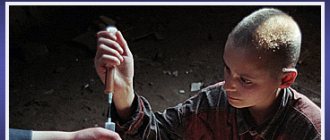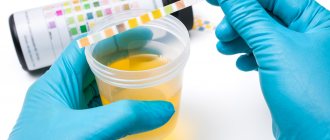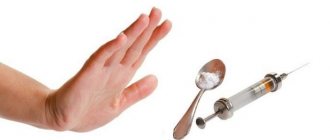Facts about drugs and addiction
- Excessive use of alcohol and drugs causes mental and physical dependence.
- Social, psychological and neurobiological factors play an integral role in its development.
- Abuse causes a number of adverse consequences affecting the psyche and health of a person. This affects behavior, ability to work and learn.
- To stop abusing any drugs or alcohol, you need to enlist the help of a specialist.
Drug addiction treatment
You should not neglect this problem and consider the addict a lost person. You should immediately contact qualified specialists; self-medication is strictly prohibited. Treatment of drug addiction is a long and labor-intensive process that requires patience and strength, but it is quite possible to overcome the disease.
The main aspect in successful treatment will be the patient’s desire to complete the course and return to a healthy life. It is necessary to complete the course fully, this will help avoid relapse of the disease.
Drug addiction treatment is a set of measures that will eliminate physical and psychological dependence. Initially, detoxification is carried out, which helps to cleanse the body of toxins, then the patient is prescribed a general strengthening course of medications, vitamins and sedatives. After the patient’s physical well-being is normalized, he undergoes rehabilitation and resocialization.
Addiction treatment is divided into four stages:
- Elimination of withdrawal symptoms and cleansing of the body.
- Restoring the functioning of all internal organs and systems of the patient.
- Procedures are prescribed to eliminate psychological dependence.
- Activities that help eliminate relapse in the future.
Drugs and drug addiction
Drug addiction (drug addiction) is the abuse of psychoactive substances, which brings temporary and false positive emotions, but causes harm to a person’s health.
Provided that the use of the drug does not comply with any medical recommendations. Drugs are a spectrum of psychoactive substances that are addictive.
Psychological and physical dependence (withdrawal) are the most common motives for regular drug use.
Types of drug addiction
Drug addiction is a serious problem of our time. The issue of drug addiction has been troubling humanity since ancient times. Opiums, hemp, coca are the progenitors of modern drugs. After the appearance of the first narcotic substances, it took some time to see these drugs as a social problem. But now everything has reached a new level, the number of types of drug addictions has increased, and this problem has acquired a new color.
Today there are different types of drug addiction. Knowing and understanding the differences between all types of drug addiction is necessary in order to understand how to help a drug addict. Naturally, most drug addicts do not realize that they have an addiction, despite the fact that they regularly use drugs. Often, this is typical for drug addicts who use substances whose effects are not accompanied by physical withdrawal.
The opium type of drug causes direct physical addiction - a person cannot stop using it due to constant discomfort and pain. Hallucinogens, psychedelic substances, and stimulants cause addiction at the mental level. This type of addiction is much more difficult to cure.
Treatment of all types of drug addictions is possible!
Rehabilitation eliminates addictions. Professional psychologists and specialists at our center have extensive experience in getting rid of various types of drug addiction of any complexity.
Main types of drug addiction.
- Opium - accompanied by taking opium drugs. The most common drugs: heroin, desomorphine, methadone, morphine. Such addiction occurs on the basis of medications or herbal substances. Opium addiction itself is divided into types such as heroin addiction, methadone addiction, and morphine addiction.
- Amphetamine addiction is very common among young people. Amphetamine (ecstasy) has a detrimental effect on the body, causing side effects, and an overdose can be fatal.
- LSD is mentally addictive after the sixth dose. This drug acts immediately on the brain. Taking this drug leads to suicidal tendencies and schizophrenia.
- Spice is a new type of drug. Spice itself appeared not long ago, like all smoking mixtures. The synthetic drug spice is a pharmaceutical herb completely saturated with a chemical solution. Addiction appears after the first dose, due to the synthetic origin of the substance.
- Cocaine, like other plant psychostimulants, occurs immediately. At first, cocaine is used by smoking and inhaling, but after constantly increasing the dose, it requires intravenous administration. Those addicted to cocaine most often die from an overdose.
- Butyrates are a modern medical drug that is currently very popular among drug addicts. Butyrates (sodium hydroxybutyrate) cause instant addiction even after a minimal dose
- Marijuana (hemp) - mistakenly has the status of mild dope. People who use marijuana are absolutely confident that it is harmless. The consequences are obvious after 2-3 years, when the human brain is not able to produce serotonin on its own, so the drug addict must constantly use marijuana.
- Salt is by far the most dangerous drug. Since it is a very cheap drug, most drug addicts prefer it. Absolute destruction of the body, vital organs and brain - salt brings with it.
It is not possible to quit drugs on your own, which is why a drug addict, regardless of the type of illness, must immediately receive professional help. Any drug is harmful to human health, which later leads to death.
If you notice signs of addiction to any chemical substance in your loved one, you should immediately contact us for help. After all, the life of a drug addict is terrible and short. Timely determination of the type of drug addiction will help you choose the right treatment tactics.
How drug addiction manifests itself
Addiction can be either a mental or physical condition. It includes:
- Changes in character and way of thinking.
- Obsessive desire to get a dose of the drug.
- A feeling of psychological discomfort in the absence of a new portion of a narcotic substance.
- Changes in behavior, in particular the appearance of aggression against the background of withdrawal.
Depending on the type of substance abused by the patient, the development of stable mental and physical dependence occurs over a different period of time. For example, when using amphetamine it is 1-2 doses, and when chewing khat leaves it is several months.
Mental and physical dependence in drug addiction
Mental dependence syndrome and physical dependence syndrome are the two main drug addiction syndromes.
Physical dependence syndrome includes an increase in tolerance and the formation of a withdrawal syndrome with regular drug use. The rate of formation very much depends on the drug and the individual physiological characteristics of the person. Most drug treatment practitioners consider the impact of physical addiction to be exaggerated. With rare individual exceptions, sudden interruption of drug use does not pose a mortal danger to the drug patient, but is the cause of unpleasant subjective experiences associated with a complex of physiological disorders, enhanced by mental discomfort and craving for use. Subjectively, the negative perception of withdrawal is enhanced by the fact that the addict knows from experience that taking the drug will relieve him of unpleasant symptoms. In society, the drug addict does everything possible to avoid withdrawal. At such moments, his behavior in the family becomes unbearable. The degree of suffering is exaggerated consciously or unconsciously as a tool for manipulating loved ones, formed into a behavioral stereotype.
What is typical is that in conditions where it is impossible to manipulate, for example, in a prison cell, withdrawal symptoms are tolerated much easier by patients in the absence of illusions of possible close use. In practice, drug addicts detained by law enforcement are not treated for withdrawal symptoms in any way, which is what doctors do in drug treatment hospitals.
Modern synthetic drugs - spices or “salts” may not give visible signs of physical dependence at all, that is, drug withdrawal does not entail any noticeable physiological disorders (what is observed in opium addicts - fever, pain, diarrhea, rhinorrhea, etc.). The basis of this addiction is an irresistible, often unconscious craving for taking the drug.
It is necessary to understand the significant difference between withdrawal symptoms in alcoholism and drug addiction. For an alcoholic, the period of substance withdrawal can pose a real threat to life and at this time mandatory pharmacological support is required.
Mental dependence syndrome is simply the way of life of a drug addict, his habits and stereotypes of using drugs in various life situations, solving problems through drugs, “escaping reality,” and spending leisure time in a state of intoxication. Drug addiction displaces a person from the usual social atmosphere and after some time the addict begins to oppose himself to a society that fears and shuns him. A drug addict loses the skills of ordinary life, moving into a drug-addicted parallel reality. A specific social circle and dominant interests are formed, directly or indirectly related to the drug.
Stopping drug use is quite possible and almost all drug addicts do it from time to time. Every experienced drug addict can talk about several periods of relief, lasting from several days to weeks, when the use of the drug was stopped deliberately - as an attempt to stop using or as a result of circumstances (detention by the police, inability to find or buy the drug). It is incredibly difficult for a drug addict to break out of the drug addict’s lifestyle and return to the lifestyle familiar to most people. This is precisely what mental dependence is, which, intensified by physical dependence, is essentially drug addiction in the usual understanding of this phenomenon by society.
The influence of both syndromes on each other enhances their effect on humans.
Treatment of drug addiction involves completely stopping the use of any psychoactive substances, including alcohol. Controlled use is impossible for a drug addict; any such attempts will inevitably lead to a breakdown. To solve a therapeutic problem, it is necessary to undergo long-term rehabilitation, during which a person learns life skills that do not involve drug use, and also studies in detail all the factors that can provoke him to relapse and learns to avoid or control these factors.
Eduard Rakhmatullin
Types of drug addiction
- Mental dependence. This means that a person achieves a feeling of well-being and satisfaction from taking the drug. He regularly experiences a strong desire to take the drug again to maintain and enhance these feelings.
- Physical dependence. This is the result of the body's adaptation to matter. Therefore, physical symptoms occur when the drug stops entering the body.
The most common symptoms are:
- nausea;
- diarrhea;
- tremor;
- headache;
- fever and even seizures.
These conditions are called withdrawal symptoms. Both mental and physical dependence contribute to the appearance of characteristic symptoms. This means that the addicted person uses more and more time and effort to obtain the drug.
External signs of drug addiction
Here are some visible manifestations of drug addiction that are characteristic of addicts:
- Detachment, absent-minded look.
- Unnaturally dilated or constricted pupils.
- Wearing long sleeves in any weather and season, even in hot summer. If you can see your bare heels, pay attention to your feet; experienced drug addicts manage to shoot up even in them. But this is the case with injectable illegal drugs, not snorting drugs.
- Untidyness: dry, sometimes poorly combed hair, swollen hands, unhealthy rotten teeth, giving off a yellowish tint.
- Hunched over.
- Unintelligible, slow speech.
- Nervousness, irritability, clumsiness of movement despite the fact that there is no smell of alcohol in the mouth. Rude attitude towards others.
- Injection marks visible on the hands.
Note that drug addicts are very resourceful and inject themselves into different places on the body, even into the scalp. Often, injection marks merge with bluish-purple dense areas on the veins.
What contributes to the development of addiction
To become addicted to a substance, it must be available in the community. In addition, there is a mixture of psychological and neurobiological conditions that may contribute to susceptibility to drug addiction.
Many substances (such as alcohol) make a person feel alert, well-being, relaxed and satisfied. It becomes an escape from the problems and difficulties of everyday life.
A number of medications relieve unpleasant symptoms, such as:
- pain - morphine-like substances;
- anxiety - benzodiazepines;
- sadness, depression and insomnia - antidepressants and sleeping pills.
These are the reasons why a person continues to take drugs, although he is well aware of their harm.
Why do people develop drug addiction?
The main reason for the problem of drug addiction is dissatisfaction with life.
The deficiency of this feeling pushes a person to seek compensation in harmful substances that help him get the pleasure that he has been waiting for in life for so long. Another reason is improper upbringing in the family. In such a situation, there is a lack of trust and mutual understanding between family members, which paves the way for children to lead a destructive life. The likelihood that such teenagers will grow up to be drug addicts increases numerically.
Who is prone to addiction?
Anyone, regardless of age and gender, can succumb to temptation. Some are much more vulnerable to abuse than others. Often these are people who have a lot of unresolved problems or individuals with low self-esteem. They may have difficulty communicating or feel that the demands placed on them by the environment are greater than they can meet.
In this context, it seems that individual personality characteristics, past life experiences and upbringing conditions may play a decisive role. However, no clear conclusions can be drawn on this basis. Drug abuse and addiction can develop in people who previously seemed stable and well-adjusted, or even in children from seemingly affluent families.
In recent years, it has been discovered that neurobiological changes also occur in the human brain, which subsequently become dominant. This leads to the fact that an addicted person cannot fully feel comfortable and experience positive emotions without using a portion of drugs. If he does not take a drug to which he has developed an addiction, then the world around him seems gray and hostile, and life loses its meaning.
Content:
- Causes of drug addiction
- How to determine the development of drug addiction
- Signs of drug intoxication
- Consequences of drug addiction
Drugs and addiction are the scourge of the 21st century.
Dependence on psychostimulants is a disease fraught with great danger. It has a negative impact on all areas of human life: it leads to disruptions in the functioning of internal organs, the brain, and contributes to the development of mental disorders. If drug addiction treatment is started in its early stages, the chances of a speedy recovery are many times higher. If a person has been “on the needle” for several years, he has to fight the addiction much longer. Given this, it is important to know the main signs of drug addiction in order to recognize it in time in a friend or relative.
Social aspects of drug addiction
Drug abuse usually develops at a relatively young age. Statistically, the risk of addiction in adulthood decreases. Young people love to gather in an environment where they find friends with similar views and interests. In such a society, it is easier to enter a state of dependence by following the bad example of peers.
At the initial stage, it is an interest in which curiosity forces a person to try. After consuming several portions of a narcotic substance, a persistent physical and mental dependence is developed. Further, the range of interests of such a person is reduced only to the extraction and use of drugs, and the dependence on them becomes stronger.
Mental signs of drug addiction
Drug addicts may experience the following psycho-emotional symptoms:
- Constant nervousness, irritability, irascibility.
- Unstable emotionality, unexpected mood swings for no reason - from anger to enthusiasm, from euphoria to depression. The emotional background of drug addicts is unstable, it can constantly change, a person in this state can even be extremely angry and aggressive, capable of inappropriate actions. He may be depressed, go to the restroom and come out in a great mood, friendly and smiling.
- Apathy, long-term depression.
- Unmotivated aggressiveness.
- Bouts of euphoria.
- Obsessive thoughts and actions, manic behavior, for example, constantly cleaning things up, scratching the skin or touching the hair, other signs of manic behavior.
If you have the listed mental signs of drug addiction, you should think about making an appointment with a narcologist. Or I’ll call this specialist to your home to talk with the alleged drug addict.
What substances are addictive
People become addicted not only to illegal substances, but also to the drugs they receive from their doctor. It is also possible to become dependent on medications that are not considered drugs or on alcohol.
The most common illegal drugs that are abused are;
- cannabis;
- hallucinogens (PCP, LSD);
- amphetamine;
- ecstasy;
- cocaine;
- crack;
- heroin
and this is not a complete list.
Among the drugs is a group of sedatives and painkillers. For example, benzodiazepines or morphines.
Types of drugs - features of drug addiction.
During its existence, human civilization has discovered and created many substances that in one way or another affect the human psyche.
The development of chemistry and applied sciences in recent decades has led to the synthesis of many new drugs that do not exist in nature. The whole variety of psychoactive substances can be divided into several groups: 1. Opium derivatives.
This group includes all substances obtained from plant raw materials - the opium poppy (morphine, poppy straw, acetylated opium, omnopon), as well as their synthetic analogues (heroin, methadone, fentanyl, buprenorphine).
2. Cannabinoids
are psychoactive substances obtained from hemp (Latin: Cannabis sativa).
This group includes marijuana (crushed parts of the plant), hashish (thickened plant juice). 3. Medicines that have a sedative and hypnotic effect
.
These are derivatives of barbituric acid (phenobarbital), benzodiazepines (phenazepam, Relanium, etc.), zopiclone ivadal and many others. 4. Cocaine
is a product of processing coca leaves (Latin: Erythróxylum coca).
5. Synthetic drugs
are the largest group.
These substances occur through a chain of chemical reactions and are not found in nature. The chemical formulas of these substances may differ significantly. These include ecstasy, amphetamine (and its derivatives), spice, ephedrine and many others. Often substances from this group have a psychostimulating effect. 6. Hallucinogenic drugs
. Also a broad group of substances, including both natural and synthetic compounds. Another name for them is “Mind-altering drugs.” The most famous are LSD and psilocycin mushrooms.
Another classification of drugs divides them into substances of plant and artificial origin, but the above gradation of surfactants is much more objective, since it reflects the characteristics of drug addiction that arise when using substances from this group. So what are they? - these features.
How to identify addiction
If you find that you are using substances:
- leads to health problems;
- affects performance;
- causes discord in the family;
- affects the mood;
- impairs memory and concentration;
- worsens relationships with loved ones;
- requires a large amount of material resources;
- cannot be terminated on its own;
- leads to discomfort when absent.
It means you're not doing well.
Even the presence of some of these symptoms already indicates a pronounced drug addiction and requires medical attention.
Causes of drug addiction
The causes of drug addiction are the second most important issue. Why does a person suddenly become a drug addict? There are risk factors that can lead to drug addiction when a person is exposed to drugs. Let us note that every teenager today has a chance to encounter them. The main risk factors for addiction are:
- in most cases, dependent people grow up in destructive families, i.e. where there were dependent people, there was physical and psychological violence
- families where there is formal communication with each other, where there is no habit of warm and close relationships (between dad and mom, mom and grandma, dad and older brother, etc.). In such families, a teenager, as a rule, goes to friends on the street for advice, authority and confidential conversation.
- authoritarian families, where there are strict rules and many restrictions that are not supported by explanations and arguments: “Do as you’re told, it’s too early to ask questions.”
- when parents, due to objective reasons, are still busy with work, careers, younger children, education, and each other.
Based on these factors, it is possible to derive a list of those needs that a child, teenager, or young person cannot, does not know how to satisfy environmentally and naturally. These are the needs for:
- self-importance,
- security,
- trust,
- self-expression.
Everyone has these needs. Having not found a way to satisfy them, and having encountered a drug, a teenager (usually the age of initiation is 14-15 or 16-17 years old) finds the illusion of satisfaction in it. Fear, boredom, laziness, loneliness, uncertainty, and anxiety disappear. They are replaced by confidence, peace, and joy. The teenager will learn that he will have to pay very dearly for this much later.
What is the danger of drug addiction?
If a substance is used over a long period of time, personality changes occur. As a rule, the addict becomes indifferent and rude. He begins to neglect education, work and relationships, and behaves aggressively.
- Discontinuation of the drug provokes serious adverse reactions. This causes unpleasant physical symptoms and in advanced cases is fatal.
- Drugs provoke mental problems and cause acute and chronic psychosis. They manifest themselves in the form of hallucinations, persecution mania and clouding of consciousness.
- The number of suicides among drug addicts is also increasing.
- Those who use syringes are susceptible to HIV, AIDS and hepatitis.
- In a state of drug intoxication, the risk of getting into an accident or becoming a victim of an accident increases.
- The constant desire to obtain additional medications leads to financial problems. They push people into crime and prostitution.
- Relatives suffer from the behavior of an addict. Most often these are children, spouses, parents.
Consequences of drug addiction
Nothing good awaits a person who takes drugs and refuses treatment. Drug addiction leads to serious illness and death. The patient also degrades socially - friends and relatives refuse to communicate with him, because it is almost impossible to do so.
The prognosis for drug addiction is determined by the duration of abuse, the type and severity of the disease. A lot depends on the patient's motivation. If he does not want to be treated, refuses to be hospitalized in a specialized hospital, and does not follow the prescription of a narcologist, the chances of success are minimal.
It is important to understand that a long stay in a rehabilitation center has a positive effect on the recovery process. Short courses of inpatient or even more so outpatient treatment often end in failure. This is due to the fact that the addict, not isolated from his usual environment, succumbs to the temptation to take the “last” dose.
Need some advice?
OR CALL A DOCTOR
CALL!
+7
How does the fight against drug addiction work?
As the negative effects of drug abuse become more apparent, longer and more intensive treatment is required.
The most important thing is identifying the problem and the person’s desire to work on it.
The process of getting rid of drug addiction comes down to the following steps:
- Dependency detection.
- Awareness of the problem and willingness to work on it.
- Seeking qualified help from a narcologist.
- Cleansing the body of drugs.
- Working with a psychologist and getting rid of psychological addiction.
- Subsequent preventive measures and restoration of health.
A big role in this process is played by the support of loved ones, necessarily non-drug addicts, and a change in social circle.
Prevention of drug addiction
Is it possible to prevent the development of drug addiction? Are there any methods of prevention? Undoubtedly. But preventing drug addiction makes sense only when the drug has not yet entered the life of your loved one. If the acquaintance has already taken place, we should already talk about treatment. So, to prevent drug addiction, try the following:
- sincerity in communication. Don’t be afraid to admit weaknesses and mistakes, talk about fears and anger. But exactly, talk about it, express these feelings. Teach this to your teenager by example.
- Make the rules in the family clear, clear and negotiable. Let them be constant and not change depending on your mood.
- Don’t try to do for your loved one what he can do himself. Make it clear that he can always ask for help, but don't force it.
- don't scold for the truth. Never! Even if you really want to.
- allow mistakes to be made, explain the consequences, but do not punish. This is an experience.
- ask for forgiveness if you are wrong. This will only earn you respect.
If you cannot find a common language with your loved one, with your child, husband, wife, parent, do not hesitate to seek help from a specialist. Sometimes, one or two meetings with a psychologist or family counselor help prevent an impending crisis. The Ibis RC family support program exists not only to help patients of our center, but also helps families to prevent addiction.
The form of work is selected individually by specialists. This could be training, pair work, family counseling, or individual work. Asking about what to do when in doubt is not shameful or scary. But it can be very scary to realize at some point that a lot of things could have been corrected before, but that chance has already been missed.











